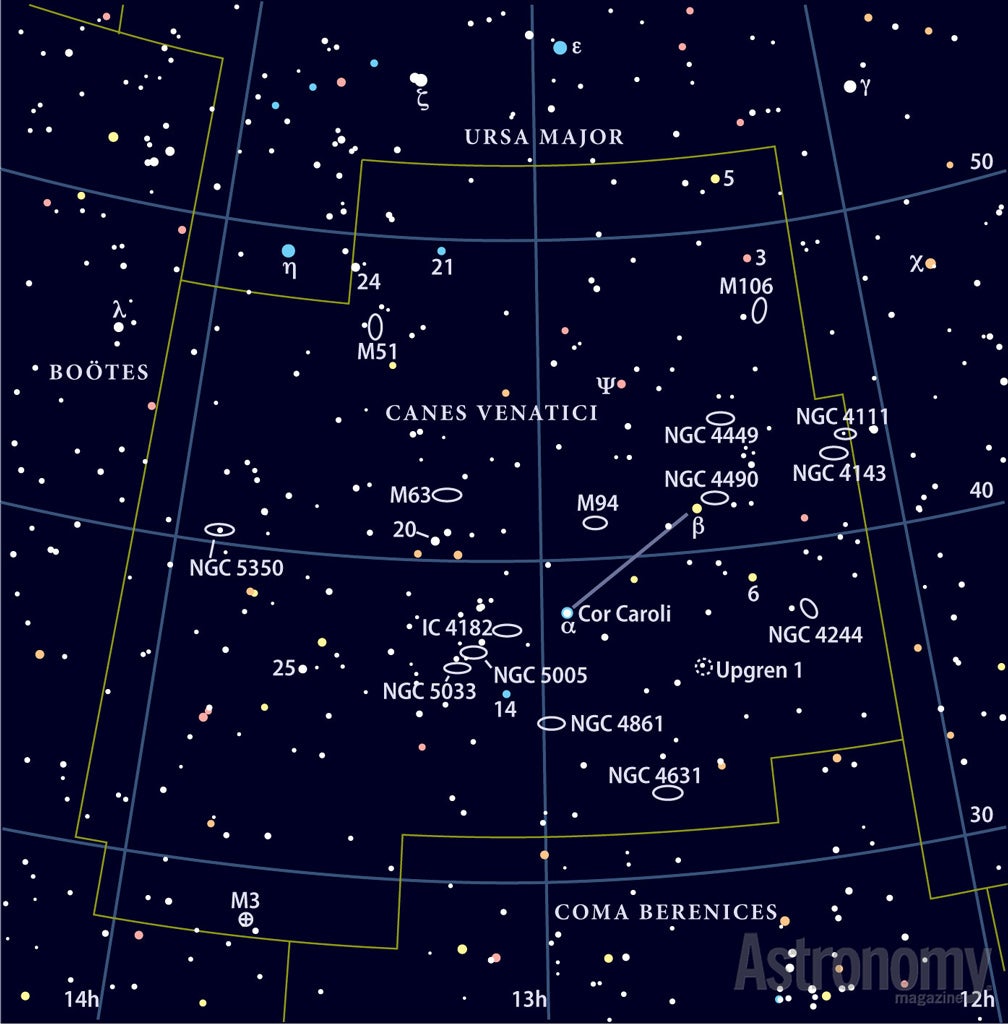Targets for March 26–April 2, 2015
Small telescope: Double stars Algorab (Delta [δ] Corvi) and ADS 8573
Small telescope: Elliptical galaxy M49
Large telescope:The Cocoon Galaxy (NGC 4490)
This week’s first small-telescope target is a pair of double stars in Corvus the Crow. The first, Algorab, also goes by the name Delta (δ) Corvi.
Algorab is the “pointer” star in Corvus that lies closest to Spica (Alpha [α] Virginis). The magnitude 3.0 primary and magnitude 9.2 secondary shine blue-white and orange, respectively. Luckily, the wide separation — 24.2″ — keeps the main star from overwhelming its companion, so the colors are nicely apparent.
Regarding this star’s name, according to the J. K. Rowling character Regulus Black in the Harry Potter series, “Algorab means raven in Arabian.” OK, maybe so.
But a better explanation seems to be the one put forth by Richard Hinckley Allen, who wrote the seminal Star-Names and Their Meanings in 1899. Allen indicated that Algorab was a modern name that first appeared in 1803 in the Palermo Catalogue, a listing of 7,646 stars compiled by Italian astronomer Giuseppe Piazzi.
My other double star choice is ADS 8573. You’ll find this pair 3.1° due north of Algorab, but it’s not nearly as easy to split. The separation is only 2.2″. The brighter component, at magnitude 6.5, is perhaps barely visible to a naked-eye observer from a dark site. It shines yellow. The magnitude 8.6 secondary gives off an orange light. It’s a nice contrast, but use a magnification above 150x to see the stars well.
Regarding this binary’s designation, “ADS” refers to any entry in the General Catalogue of Double Stars Within 120° of the North Pole. American astronomer Robert Grant Aitken compiled this list of 17,180 double stars. The Carnegie Institution published it as a two-volume set in 1932.
Here I am!
This week’s second small-scope object is one of the least-observed items on French comet-hunter Charles Messier’s vaunted list: M49 in Virgo. Perhaps more skywatchers don’t seek it because of its designation as an elliptical galaxy, which some observers consider boring because they lack spiral arms. As you might have guessed, I’m not one of them. To find M49, look 8.5° west-southwest of magnitude 2.9 Vindemiatrix (Epsilon [ε] Virginis).
M49 is one of the sky’s brightest galaxies. It shines at magnitude 8.4. Through a small telescope, it appears slightly oval, measuring 8.1′ by 7.1′.
The core occupies the central two-thirds of this object. A fainter outer region envelops the core. Because this galaxy shines so brightly, you can crank up the power and reveal its outer halo.
A galactic cocoon
This week’s large-telescope target is a barred spiral in Canes Venatici known as the Cocoon Galaxy. It also carries the designation NGC 4490.
You’ll find this nice target 0.7° west-northwest of magnitude 4.2 Chara (Beta [β] Canum Venaticorum). Both sit in the same field of view of a low-power eyepiece. The galaxy appears as an irregularly bright oval halo (the “cocoon”) that envelops a bright central region. Its spiral arms remain invisible to all but the largest amateur instruments.
The Cocoon Galaxy is bright — magnitude 9.8 — so you can really crank up the magnification while viewing it. This object also isn’t tiny. It spans 6.4′ by 3.3′.
But don’t stop there. This object is a two-in-one treat. Look just 3′ north of NGC 4490’s western end for its magnitude 11.9 companion, irregular galaxy NGC 4485. This pair interacts gravitationally, which explains why the brighter member looks like it does.
Expand your observing at Astronomy.com
StarDome
Check out Astronomy.com’s interactive StarDome to see an accurate map of your sky. This tool will help you locate this week’s targets.
The Sky this Week
Get a daily digest of celestial events coming soon to a sky near you.
Observing Talk
After you listen to the podcast and try to find the objects, be sure to share your observing experience with us by leaving a comment at the blog or in the Reader Forums.











